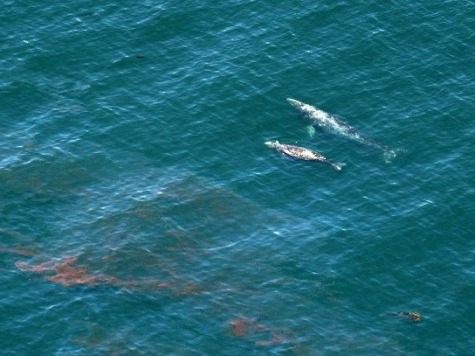The sad look of south Santa Barbara beaches after the recent oil spill is serving as a backdrop for environmental protesters to advance their causes that have little to do with the ocean’s birds and fish. But as the protesters chanted “End Oil Now!” billions of microscopic bacteria are feasting on the oil that has been on their diet for millenniums.
Raising signs and chanting alongside an inflatable mock pipeline, protesters marched against fracking as “extreme oil extraction.” They were joined by “Food and Water Watch” that demanded authorities publicly rule out the use of chemical dispersants in the cleanup of the oil spill near Refugio State Beach.
The most recent Santa Barbara County oil spill caused about 105,000 gallons of crude oil leak. One of the reasons it was not caught immediately is because the broken pipeline did not have auto shut-off valves, said Deputy Director of the county’s Energy and Minerals Division Kevin Drude. The original pipeline owner was able to skirt Santa Barbara County regulations by successfully arguing in court in the late 1980s that it should only be subject to federal oversight as part of an interstate network.
Kassie Siegel, Climate Law Institute director for the Center for Biological Diversity located in Joshua Tree said of the oil spill, “This is a tragic reminder that oil production is dirty and dangerous from start to finish.” She added, “So much of the damage that the oil companies do is harder to see.” Siegel especially opposes the use of dispersants.
But every day for the last 100,000 years there has been an oil spill off the coast of Santa Barbara, California, due to “oil seep,” according to University of California at Santa Barbara. Each day, at least 8,000 gallons of crude oil seeps into the ocean as trapped naturally occurring underground oil leaks crack in the seabed and then floats to the surface, since it is lighter than water.
Georgia Institute of Technology microbiologist Joel Kostka reported in Scientific American that the “damage” from seepage is not highly visible due to Thalassolituus oleivorans bacteria, such as Alcanivorax borkumensis, T. oleivorans. They munch on oil as a natural product of the decayed plants and animals that are part of their diet.
The bacteria extract the oil’s nitrogen for metabolic energy and release CO2 and clean water as waste products. These bacteria are found all over the world and are credited with devouring 200,000 tonnes of oil from the 2006 Deep Water Horizon oil spill in the Gulf of Mexico. The reason dispersants were used in that spill was to break oil slicks above and below the surface into smaller droplets. This assisted the bloom of billions of hydrocarbon-chewing bacteria get more surface angles to consume the oil quicker.
At the 2014 Gulf of Mexico Oil Spill & Ecosystem Science Conference on January, 27 2014 in Mobile, Alabama, Steve Murawski, with the University of South Florida in St. Petersburg said that incidences of direct mortalities on fish populations other than oysters are probably pretty low. He explained how oysters, which cannot move to escape the oil, were very negatively affected by man-made diversions of freshwater streams after the spill, rather than by the oil spill itself.
U.S. Coast Guard officials said there has been no decision to use dispersants in the Santa Barbara area, since only an estimated 21,000 gallons ran down a culvert under the U.S. Highway 1 freeway and into the ocean. With only the equivalent of less than three days of seepage in the current spill, dispersants were not necessary. But the Coast Guard has said they reserve the right to use dispersants in the future.
Most of the out-of-town protesters were upset about not being allowed to work in the clean-up. Tamlorn Chase of the activist group End Oil Now told the crowd, “If they don’t want us on the beach, well they’d better start cleaning it up. Otherwise we’re going out, we’re gonna risk our health, because we risk our health by not cleaning it up.”
As marching protesters worked to be highly visible chanting slogans and beating drums, billions of microscopic bacteria were invisibly hard at work munching on the oil spill.

COMMENTS
Please let us know if you're having issues with commenting.